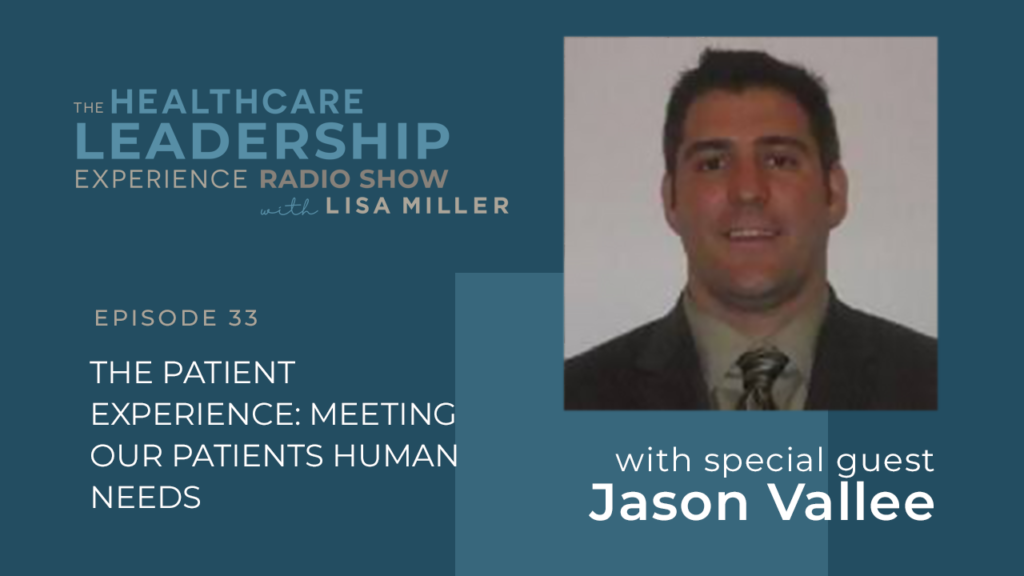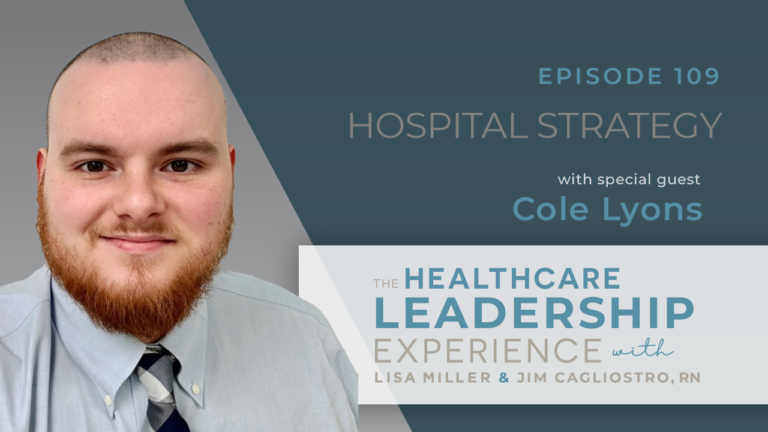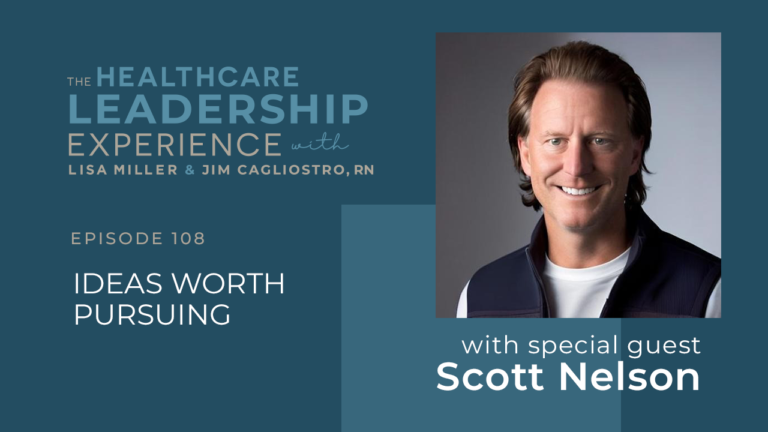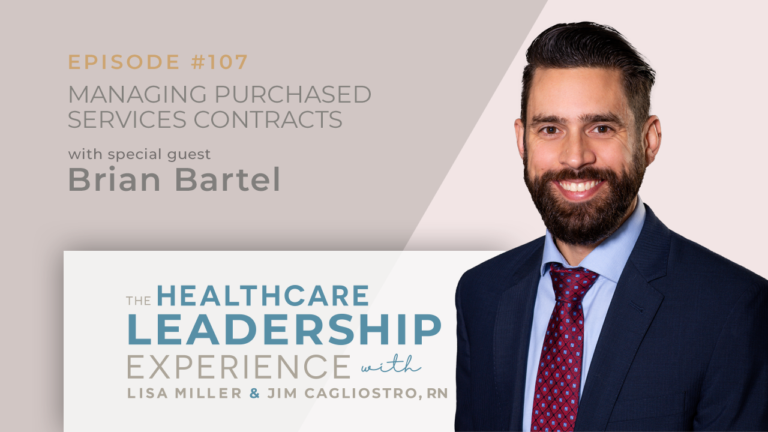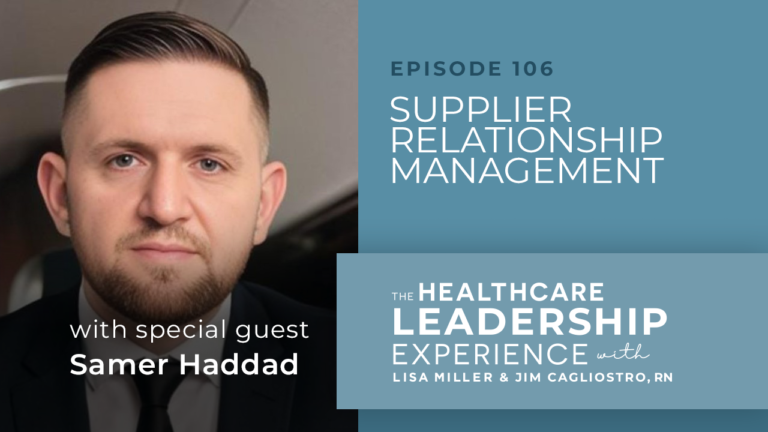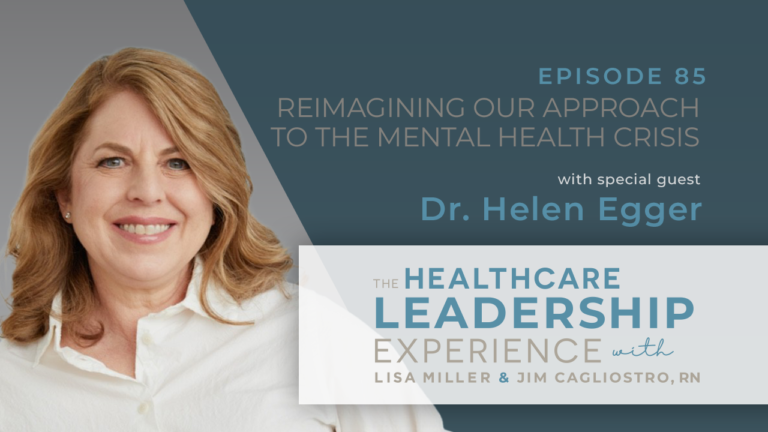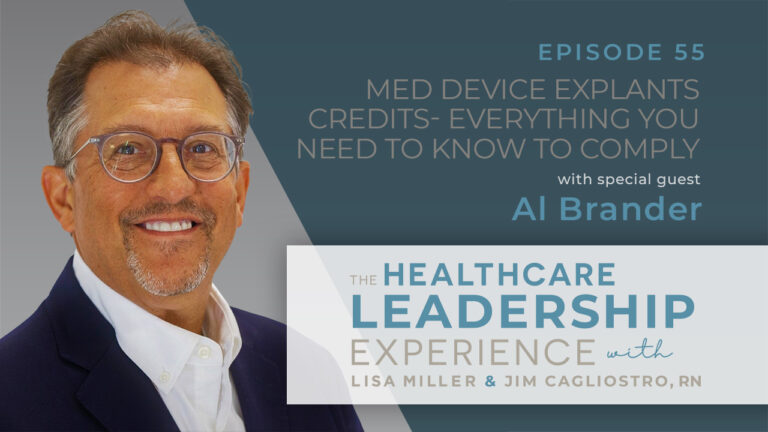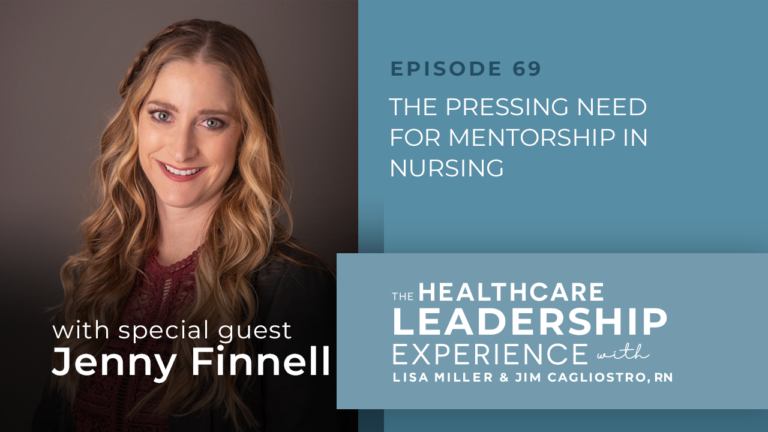The Healthcare Leadership Experience
In Episode 33 of The Healthcare Leadership Experience, Lisa is joined by, Jason Vallee, PhD, Vice President at Cheshire Medical Center, Dartmouth-Hitchcock and a thought leader in the patient experience. Together they explore what the patient experience really means.
As Jason observes : ‘’The patient journey, and what they perceive to be their journey, is much greater than we think.’’
This episode is sponsored by VIE Healthcare Consulting® which has proudly helped hospitals save $772 million since 1999.
In this episode you’ll hear:
- A singular definition of the patient experience, and how to ensure people have a positive and lasting relationship with your hospital.
- The importance of Patient Journey Mapping, and the ‘’sprinkler experience’’ that drives the need to understand the patient perspective, every step of the way.
- Introduction to the JUSST model (Justice, Understanding, Security, Self-esteem, Trust) and its pivotal role in the patient experience.
- The platinum rule of the healthcare patient experience, ‘’do unto others as they want it done.’’
- The subtle behaviors that speak volumes to your patients. Hint: don’t bury your head in the computer. ‘You may only be with them for 15 minutes, for them it might be half a day. The cost for them is much higher from a time perspective. Respect is paramount.’’
- Why health systems in the bottom third of Press Ganey rankings are facing a major problem and significant financial impact. Hint: You’re 110% more likely to be sued.
- The attention to detail that can transform your patient experience scores, and the contrasting effects of Mom A versus Mom B for one paediatrician.
- Three essential components of trust: communication, competence, contractual.
- Why 90% of patient experience coaching is focused on communication. ‘‘The words you choose to use create reality ….it’s the cornerstone of trust.’’
- Why the five elements of JUSST are key to the behaviors that drive organizational excellence in every culture.
Connect with Jason:
https://www.linkedin.com/in/jasoncvalleephd/
Connect with Lisa:
📧 lmiller@spendmend.com
📱https://www.linkedin.com/in/lisamiller/
Episode Transcript
CLICK HERE TO DOWNLOAD THE PDF TRANSCRIPT
CLICK HERE TO OPEN THE TRANSCRIPT
Introduction (00:02):
Welcome to the Healthcare Leadership Experience Radio Show with your host, Lisa Miller. Lisa is an entrepreneur, inventor, advisor and founder of VIE Healthcare Consulting, the leading healthcare advisory and analytics firm, helping hospitals accelerate their margin improvement goals. Lisa loves to think differently and collaborates with leaders and their teams to solve challenges and to create new innovative approaches that impact the clinical and business side of healthcare. Our show will bring you leaders and innovators within healthcare and across multiple industries. Be a part of the discussion that will give you a unique perspective, deep insights and roadmaps to successfully help you navigate the clinical, financial, and operations of healthcare. Your show starts now.
Lisa Miller (00:49):
Hello, you’re listening to the Healthcare Leadership Experience on HealthcareNOW Radio, I’m your host Lisa Miller. And today I have a great guest. I’m so excited to have Dr. Charles Vallee here on the Healthcare Leadership Experience Radio Show. I’d like to give you a little background on, uh, Jason. He is really a thought leader in the patient experience. He has over 20 years of leadership and organizational development experience for for-profit and nonprofit business sectors. Currently, serves as the vice president of patient experience at Cheshire Medical Center in Dartmouth-Hitchcock, in New Hampshire. In this position, Jason directs and manages the day-to-day operations of the patient experience program for the physicians, administrative leaders and all staff.
Lisa Miller (01:39):
What I’m really going to enjoy is Jason’s perspective because he also serves as a physician and an executive coach on the curriculum development and in all areas, as it relates to working with physicians and those on the front lines. And he’s also responsible as the administrative lead for the physician provider ambassador program. And we’re gonna talk about all different things. It’s such a interesting work he’s doing. Jason, welcome to the show.
Dr. Charles Vallee (02:10):
Well, thanks for having me.
Lisa Miller (02:11):
We’re going to be speaking about the patient experience — but I think from a very unique perspective, a new way of kind of thinking and a new approach. So how do define patient experience?
Dr. Charles Vallee (02:26):
That’s a great question. In fact, it’s one I ask all the time and, and what happens is if I ask a room of 59 people, you know, what is patient experience? I might get 59 different answers. And of course, there’s overlap and similarities in what people say — but by and large, there’s a lot of disagreement and discernment when it comes to understanding, uh, what goes into defining the patient experience. And so we’ve spent a lot of time really trying to get to understanding and sharing one definition of what an experience is for a patient. And that is really it’s an amalgam, or all of the, the sum of the interactions that occur from the moment you interact with a health system until you’re no longer doing that.
Dr. Charles Vallee (03:04):
And those interactions are, um, perceived one way or another. And those perceptions really begin to frame with the experiences for the patient. This of course is shaped by your culture and the way you behave at your health system or healthcare organization. And so we define it as really trying to understand what behaviors that we can do to guide those perceptions so that people will have a positive, trusting and lasting relationship with our organization.
Lisa Miller (03:31):
So you and I have had a previous conversation, I wanna infuse one aspect. You and I had the opportunity to talk about patient journey maps, but you have really been a leader. You’ve been doing these journey maps, process maps for years. And you and I have had the opportunity to kinda share notes and talk about how patients may even, you know, their journey starts as they’re getting outta their car and coming into the hospital could be for surgery. Can you just, I love the story, I shared my experience with you, but I loved your story even better, that patient experience, where the sprinkler was going off in the morning as they got there early for a case (laughs). And I, it’s just, I’ve been thinking about that for days now. It’s, you know, things we don’t think of…
Dr. Charles Vallee (04:16):
Yeah. So many times, you know, when we’re within the hospital or clinic walls, and we’re trying to define these processes and ways about going about business and trying to make it so that the patient feels as though, you know, we’re introducing ourselves and being comforting to them. You know, we’re asking an open-ended question so that we can find out what’s on their mind, that sort of thing. And we’re doing all these things and we map that journey. And so it wasn’t long ago that we decided to map our ambulatory journey and try to understand what it was that drove our patient experience, for the good or for the bad. In one particular case, we had actually several patients point out that when they show up to get same-day surgery, they’d like to do that dry rather than wet. And so not even thinking about what occurs when you come to the parking lot.
Dr. Charles Vallee (04:59):
We had several patients point out that our sprinkler had fade out and come on perfectly timed to soak people just as they’re walking up the sidewalk. Uh, so they had the choice. They could either get hit by a car by jumping into traffic or get wet. And so many of them got wet and, uh, really the patient’s journey is, and what they perceive to be their journey is much greater, I think than sometimes we think. The patient’s perspective and understanding in empathic compassionate way is really, really important. And our work here is guided by what we call a patient and family advisory council. And we use that council to really make sure that we’re checking our assumptions of what the experience and perceptions might be for our patients. And yeah, uh, we soaked a few people, it was an easy fix and sure enough, that does impact your scores.
Lisa Miller (05:42):
I appreciate the story, but I think it speaks to how many touch points, how thoughtful, how detailed and deep and end-to-end that we’ve gotta look at the patient experience. So I wanted to just mention that on our show today, because I think there’s a lot of those incidences that happen. And either we’re not aware of it, or maybe we don’t think it’s important, ’cause we think, well, we just wanna get them to surgery and have a great outcome. But I think we have to be thoughtful about the entire journey. What are human needs versus expectations? I know there’s definitions around what someone needs versus expectations, and I’d love your perspective on that.
Dr. Charles Vallee (06:21):
Sure. This is a direct question that comes to me from an experience that I had. And when I took this job — God, a couple of decades ago now, I was working for a CEO who was known to be super, super intelligent, but also super, super demanding. And I was a little bit worried that the newbie in the role, coming to this particular person and getting ready to discuss what the job would entail. And I knew my job was to improve the patient experience. How I went about that was a whole another question, right? And so I met with the person and I had filled out seven or eight pages of tactics and goals, and statements of how I was gonna achieve excellence in the patient experience. And I was pretty proud of the work. I had really prepared for this meeting.
Dr. Charles Vallee (06:59):
So I show up and Dr. CEO says to me, “What is all this?” And I said, “Oh, this is my 19-point plan for achieving excellence, 5 stars, whatever in the patient experience.” And she laughed at me and she pushed it calmly across the table. And then she looked me dead in the eye and she said, “Jason, your job is easy. All I want you to do is meet and exceed the expectation of every single patient that walks through any of our doors.” Well, I worked for a health system all across New Hampshire and Vermont, that was terrifying. There are 13,000 people that work here and my job again, was to meet and exceed expectations. And the word that I really hung on was expectations. Because if you think about it, expectations, you know, are they limited? Is there just a set of 9 or 10 of them or are they sort of unlimited?
Dr. Charles Vallee (07:43):
Are they universal? Do we have all the same set of expectations or are they deeply personal? And finally, are expectations something that are static or do they change? So Dr. CEO, when she said to me, I want you to meet and exceed expectations of every patient that walks through every door, the volume of that was just crazy. But the theory that I could meet and exceed something that is virtually unlimited, deeply personal and possibly unknowable and always changing, is logically impossible. How do you do that? And so I freaked out and when I freak out, uh, like many of you, I, uh, have a certain thing that I do. And one of the things I do is I like to research, I like to read, and I think to myself that somebody else must have faced this exact problem of trying to meet and exceed something that is always changing, deeply personal and unlimited.
Dr. Charles Vallee (08:28):
And I said, “Well, somebody else must have looked at this before.” And I did. I found a group out of Chicago that had done a bunch of research, both inside and outside of healthcare that was talking about the notion that just because there’s a saying meet and exceed expectations, doesn’t necessarily make it true and doesn’t necessarily make it possible. And what their research showed was that there were five core needs for any customer, whether it’s a healthcare client, a patient, or outside of healthcare. And if you meet those five core needs, they’re more than likely to give you whether it’s a 5-star review or on a Press Ganey patient survey a 9 or a 10 on a scale of 10. And, and they’re much more likely to rate your organization as, as being excellent. And this of course brought me a lot of calm.
Lisa Miller (09:11):
I can’t wait to hear the five core needs, but no, I want you to continue with the story.
Dr. Charles Vallee (09:15):
Yeah. So the five core needs. Um, a- and they kind of fit neatly into a model that I use called the JUSST Model and it’s justice, understanding, security, self-esteem and trust. Now the first one, justice is a strange word to describe a need and it’s actually respect. But if I use respect, understanding, security, self-esteem and trust you’ll note that that’s the RUSST model. And that’s a little weird.
Lisa Miller (09:34):
Yeah (laughs).
Dr. Charles Vallee (09:34):
So I went with the JUSST model and I used my thesaurus and, and came up with justice, and really there are a lot of behaviors that you can hardwire that are relatively simple, that conveys that you’re respecting somebody. And on the inpatient side, that can be sitting eye to eye with the patient and really investing your listening skills and, and things like that. On the outpatient side, that’s not burying your head in your computer, but rather spending time again, eye to eye with a patient and being in the moment. For them, it’s their big day when someone makes an appointment and then they have to wait to come in and then they’ve gotta wait in a registration line. They’ve gotta wait in a waiting room. Then they’ve gotta wait in the exam room. You may only be with them in interacting for 15 or 20 minutes, but for them it might be half an day. And so the cost to them is much higher from a time perspective. So respect is paramount.
Lisa Miller (10:21):
I just wanna make a comment about the respect and justice. I actually like the word justice too. I think there’s a lot in there. My dad recently had to do, uh, registration for a surgery and, you know, there’s very lovely people, nice process. It seemed to flow. Somebody really smart was kind of putting it all together. But what I found was missing was the understanding of his own case prior to all that process. And I don’t know if, you know, in that situation, patients can remember everything they need to remember. They really want somebody that’s really gonna reach out and say, “Okay, I got this for you.” So, so I do like justice a lot. So I interrupted you. Please go ahead with your model (laughs).
Dr. Charles Vallee (11:02):
You know, we talk a lot about how do unto to others as you’d want done to you. And the reality is, is in healthcare, it’s a little different, that’s the golden rule. And we subscribe actually to the platinum rule and the platinum rule is do unto others as they want done because you’re not the sick one, you’re not the one giving up half a day. And it’s certainly a person standing in front of you, not number 234157, right? It’s a person. Your dad. And so we’re really focused on making sure that at a minimum that standard of respect is there. These, by the way, in this model, these justice, understanding, security, self-esteem, trust are interrelated. They overlap.
Dr. Charles Vallee (11:36):
So one behavior might cover five of them or four of them, of course. But we do call them out because if you’re missing any of the five, the likelihood that that patient had a good experience, that their perception was positive is low. And we know when patients have an experience that’s less than ideal, they’re less likely to go back there. So it hits you financially. They’re less likely to follow doctor’s orders, quote into quote. Therefore they might not do the treatment plan in the way that they’re supposed to. And of course, they end up back for something worse sometimes, God forbid, or they don’t take their meds correctly or on time, or they don’t understand them.
Dr. Charles Vallee (12:08):
So this is really important for those reasons, those malpractice reasons. One of the things we learned is that if you’re in the bottom third of the Press Ganey database for patient experience, meaning you’re in the worst third, you’re 110% more likely to be sued than if you’re in the top third, so guess what?
Lisa Miller (12:22):
Wow. I didn’t know that.
Dr. Charles Vallee (12:23):
If you are in the bottom third, call a lawyer because it’s happening. Right. So understanding has to do with listening skills. And I also talk about the distinction between dialogue and discussion. So dialogue is from “the great dialogue” and it means to flow through, where the information isn’t just bouncing off of me, it’s actually flowing through me and I’m experiencing that communication— whether it’s your body language or your voice or whatever. And contemplating my response as a result of what’s flowed through me. Whereas discussion is a lot like when I used to get in trouble in high school and my dad would say, “End of discussion.” (laughs) So the difference there is very important. Are you having a dialogue? Are you having a discussion?
Dr. Charles Vallee (13:02):
So that’s understanding, security has to do with safety. And in healthcare, quality and safety, obviously we like to say that if you cut the wrong leg off, all the smiles in the world aren’t gonna create a good patient experience, right? So you have to job one, wash your hands before you touch a patient, make sure you have the right patient in the right place at the right time, and so on and so forth. So we’re very clear that the cornerstone and fundamental of all of our patient experience programming has to do with making sure we keep our patients safe. Patient experience at Dartmouth Hitchcock across our system does report into our chief quality officer. It is part of our quality and safety programming, which I love.
Dr. Charles Vallee (13:39):
So we have justice, word you like, understanding, security. And then self-esteem has to do with the notion that when somebody comes to you as a patient, they’re sick, they’re injured, they’re ill. You know, they’re not a hundred percent otherwise they wouldn’t necessarily be here. Of course, there’s well child checks and physicals and things, but most of the time predominantly people come to you because they’re sick or they’re injured or they’re ill. And that requires compassion and empathy. And we talk often about the difference between empathy and sympathy. For examples, I was watching and serving a nurse interaction with a patient moving from the ICU to the floors, you know, to the regular medical surgical floors.
Dr. Charles Vallee (14:16):
And during the transaction, it was a little old lady, but she was swearing a blue streak. She was very unhappy. And this place that, and this place this, and she said, “I cannot sleep. It is so loud. It is so loud.” Now our ICU right now is loud. We have ventilators and everything else going on in there. It’s not a quiet place to be. And the floor is much quieter. So when she said to the nurse, “I can’t F word sleep.” First off, I was taken aback, ’cause again, this was like a little grandmother (laughs) who was swearing (laughs). And then second, the nurse looked at her right in the eye and said, “You’re right. It’s not quiet here.”
Dr. Charles Vallee (14:45):
And my heart sank. So that sympathy, sympathy is saying, “Oh yeah, that sucks.” I, I can see that stinks, but not doing anything about it because you’re not enjoying the opportunity to invest in that lived experience. It’s not you, it’s over there. And as a result, and I talked with the nurse and I said, “You know, what were you doing there?” And she said, “Well, I was really trying to be empathic. I was really trying to empathize with her.” And I said, “Well, all right.” And so the nurse had another nurse in the room that was doing the transfer and he politely stepped in and said, “Oh my goodness, I do understand it can be very loud in the ICU. I’ve got great news. Here on med-surge it’s very much more quiet. We don’t have all those machines and such. And furthermore, I have melatonin, which is a natural way to help you sleep if you’d want that. And we also have some earplugs we can provide you.”
Dr. Charles Vallee (15:30):
He took the position as if it was, I can’t sleep. Not you can’t sleep. So in terms of self-esteem and in terms of treating people like people, it’s really that empathy and compassion, it goes so far and a casual observer would’ve said, “Oh yeah, the, the nurse commiserated. You’re right. It’s loud here.”
Lisa Miller (15:47):
Before the nurse, there’s nothing for the nurse to do the, it is what it is. And I wanna go in deeper a little bit more on that because I have a question for you as it relates at a healthcare application.
But I want everyone to know that if you’re just tuning in, you’re listening to the Healthcare Leadership Experience Radio Show on HealthcareNow Radio, I’m Lisa Miller, your host. Today I’m joined with Jason Vallee, VP of patient experience at CMC Dartmouth Hitchcock. We’re having a great conversation on his thinking and approach to the patient experience. This show was sponsored by VIE Healthcare, the leading advisory and analytics firm, helping hospitals accelerate their margin improvement goals since 1999. You can learn more about VIE Healthcare at viehealthcare.com.
So Jason, as we’re going through your model, I find it interesting that the nurse came in and said, “Okay, melatonin, we might move you to the floor.”
Lisa Miller (16:41):
“I’m putting myself in your shoes. I can experience it.” I believe it’s the Ritz-Carlton, one of those hotel chains that really empowers employees to help make some decisions. I give them some sort of budget or some sort of room to do things like that, right. I mean, you can’t have an unending budget, but to be able to make those decisions. And what happens is that it, it delivers this remarkable experience and it’s really little money, but at least the people have the ability to think and have solutions like this nurse was able to do. And obviously moving to a floor requires some more logistics, but the melatonin, what a fabulous idea.
Dr. Charles Vallee (17:19):
Yeah. And, and absolutely. And of course it’s non-narcotic, right? So we wanna make sure it’s a safe idea. We empower our nurses. So on the front end we have service excellence. We do a lot of training, teaching and development relative to what does it mean to truly have service excellence? There’s a great story about one of our clinics and I’m gonna use a real name here. He’s okay with it. Dr. Storo is a pediatrician. And he had a unique situation where he had two different medical assistants that roomed his patients. And they worked on different days. It was two moms that had part-time jobs. And what was interesting is we could look at his patient experience scores and see that with mom A, his scores were super high and we’re like, what’s going on?
Dr. Charles Vallee (17:55):
But with mom B his scores were not. And so we said, we have two different people who work for this guy or with him, how can his scores be so different? So we did a little test. I followed and observed both of the medical assistants and some of his nursing staff. And what we found was he was the exact same person in the room every single time. What changed was the personality of the person rooming the patient. And I quote, mom A would say, and this is why I use his real name. Dr. Storo is very thorough. He’s running a couple of minutes behind, but I promise you when he comes in, he’s gonna take great care of you and give you all the time you need. And she said it without fail, if he was behind, right. So that’s kind of a cool thing to say to somebody.
Dr. Charles Vallee (18:36):
And if you look at the respectful, the understanding piece and having two-way dialogue, treating people like people and keeping them safe and that sort of thing, she was brilliant. A second medical assistant, didn’t say that at all. She would simply say, “Dr. Storo’s late again,” and turn around and walk out. Now, not a horrible thing to say, Dr. Storo is late again on the face. But when you dig into it, what she’s saying is, oh, Dr. Storo might be somebody who’s not organized, somebody who doesn’t care about your time, somebody who’s running on his schedule, maybe I’ll beat the bagel. I don’t know. But he’s gonna come in when he comes in, sit tight. The patient sitting there, investing their time, their half a day or whatever it takes.
Dr. Charles Vallee (19:14):
And like, “Oh great, I had to be on time but Dr. Storo can’t be.” And that was the difference in the scores. And so we actually trained the second person to start saying, “Dr. Storo is very thorough. He’s gonna be in, in just a few minutes, and he’s gonna take great care of you. And he’s gonna take all the time that you need when he comes in.” And of course the scores followed. They went right up with them. So on the service excellence side, there’s training and development, and lots of it. On the service recovery side, when we make a mistake, it’s absolutely the Ritz-Carlton model. And we do have allocated budget for folks to be able to all the way up to it, including we’ve paid for gas, gas card and things like that.
Dr. Charles Vallee (19:51):
So if somebody’s come to an appointment from a little ways away being in rural New Hampshire and they’ve driven an hour or so to get here, we’re cognizant that that costs money. And we’ve done some service recovery around that. Sometimes it’s a coffee card to get out the cafeteria and enjoy a coffee and things like that.
Lisa Miller (20:06):
I love what you’re doing with empowering your team there. Yeah.
Dr. Charles Vallee (20:10):
Yeah. Uh, and it’s finally, uh, the last piece of the model is trust. And it’s funny because who of us hasn’t heard like every relationship’s built on trust, right? We’ve all heard that. And I got to noodling with that two, three years ago and said, what does that mean, every relationship’s built on trust? What is trust? And oftentimes trust is defined as doing what you say you’re gonna do, in the way you said you’d do it, and the time you said you’d have it done. And you know, on face value, yeah, that’s a great definition. One of the problems in healthcare is the doctor makes a promise that the nurse has to fulfill, or the nurse said something that another nurse or the doctor has to fulfill. So how do you maintain trust in an environment where I’m supposed to do what I say I’m gonna do, in the way I said I would do it, and the time I said I’d have it done when it’s somebody else doing that?
Dr. Charles Vallee (20:58):
So at this organization, one of the things we wanted to do was train and develop folks on really the elements of trust so that there were much more cognizant to under promise and over deliver. And what we simply said is there are three components. One is communication. So the words you choose to use create reality. And so if you say so and so will be in shortly, that can mean a lot of things to different people. But if you say so and so is gonna be in in 10 minutes if they’re not I’ll come back, that’s a very different thing. So we want to make people will really concise with their language, particularly around time, ’cause a lot of patients are paying us with their time. So that notion of communication being the cornerstone of trust is very important to us.
Dr. Charles Vallee (21:37):
You mentioned in the intro that we have a physician, uh, and provider coaching group, they’re actually, uh, 12 physicians that work with me across our system who go out, and I think we currently have 52 open coaching cases. 90% of the coaching we do is around communication, choosing the right words. And we call ’em key words at key times — and making sure that people can deal with everything from how to introduce yourself and be credible to making sure that you can deliver difficult information to somebody, or you can apologize in the right way. So we have a lot of different training on communication.
Dr. Charles Vallee (22:10):
And the second bucket of trust is really around competency. And this has to be with, am I the person, uh, do you believe I can do it, right? And so we spend a lot of time making sure our patients feel as though we’re competent. And sometimes that means saying, I’m not the person to answer that question, which also builds trust. And then the final component of trust is contractual. It’s really where the rubber meets the road, and that’s making a solid contract with somebody. And, you know, we study customer service and experience inside of healthcare, but we also study it outside of healthcare. And if you’ve recently called in, there’s an airline, um, currently that if you call in, it says, you know, you’re the 8th person in the queue, it’s approximately for 15 minutes. Would you like to have us call you back on this number? Brilliant. I hang up my phone. I go about my day and bang the phone rings in what, 12 minutes, not 15. And they do it every time I practiced and, uh, (laughs) to see.
Dr. Charles Vallee (23:02):
But the reality is is that, you know, that notion of setting a contract, we’re gonna call you back, you know, and you don’t have to do anything, you can go about your life, is another way to sort of elevate the experience. And so we’re always looking for ways that we can build trust. And so, yeah, so the model, and going back to the notion of meeting and exceeding expectations versus meeting these needs, who among us can’t meet those five core needs every patient, every time? Justice, understanding, security, self-esteem, and trust, you can do all five of those things. And it doesn’t take extra time, it doesn’t take any extra effort, it’s really just a way of being. And so when I say the definition of patient experience is the perceptions that our patients hold shaped by our culture or our behaviors, culture, behaviors that drive organizational excellence are just those five things.
Dr. Charles Vallee (23:50):
The trick is when you think about it, isn’t that any relationship? I mean, what relationship doesn’t rely on respect and understanding, being treated like a person, being kept safe in the relationship, and building trust? So those five core needs, that’s the human condition, at any culture, any person, anywhere, anytime, we need those five things in order to have a great relationship with somebody.
Lisa Miller (24:13):
I love those core needs. And I’m gonna have to wrap up in about a minute. But I wanna first say that you are an educator, you’re a thought leader. I know people are gonna wanna reach out to you. I think that you also do some speaking and certainly there would be enormous value for those listening to reach out to you if they wanted you to come or speak on a topic, certainly your diversity around the physician coaching and the patient experience, and, and the fact that you are an educator really lends itself to a lot of the hospitals that don’t have that opportunity within their system. So can you tell everybody how they could get a hold of you, or we’re gonna leave it in the show notes as well. I don’t know if there’s any way, whether it’s LinkedIn or something specific, but Jason, if you could, I, I know that you’re a valuable resource to the healthcare industry.
Dr. Charles Vallee (25:03):
Thank you. That’s very kind of you to say. So, uh, as I mentioned to you before the pandemic, I was out speaking and doing workshops and conferences probably twice a month, you know, on a consulting basis and really enjoyed doing that. It’s a learning experience for me. You go out and you learn how to integrate patient experience strategy into existing strategies. And I’ve, you know, notably have done some work at MIT Medical and many hospitals in, uh, California, US Navy Hospital, for example, and Colorado Children’s, and all across the country, really, Florida. So I’m happy to do that. You can get in touch with me either on LinkedIn. I am on there and active, or my email, Jasonc, as in Charles Vallee, V-A-L-L-E-E, PhD@gmail.com. Even if it’s just a 5 or 10-minute conversation you’d like to have to kickstart and get noodle in on some of the ways you can improve your experience, happy to do that with anyone.
Lisa Miller (25:54):
That’s great. And I could speak hours with you. This is an area that’s near and dear to my heart. I’m probably gonna ask you, we’re gonna add the show notes and maybe add a paragraph or two for the audience and where you would start to improve their patient experience, but maybe we can add that to the show notes. Thank you, Dr. Jason Vallee for your insights, new thinking, and approaches on the patient experience.
You’re listening to the Healthcare Leadership Experience Radio Show on HealthcareNOW Radio. Am Lisa Miller your host. Thank you for listening to today’s episode, and we look forward to future episodes. If you’ve got some ideas or topics, please reach out to me. Thank you.
Outroduction(26:34):
Thank you for joining Lisa Miller for this episode of the Healthcare Leadership Experience Radio Show, sponsored by VIE Healthcare Consulting. If you enjoyed the show, subscribe so you can automatically get notified when new shows premier weekly. Don’t forget to leave us a review, some more healthcare leaders like you can discover us. This show is on HealthcareNOW Radio, Apple podcast, Stitcher, Spotify, Pandora, and other major podcast platforms. To reach out to Lisa personally, you can join the conversation on LinkedIn, where Lisa continues to have discussions on the business of healthcare. You can find links to Lisa’s other social platforms in the show notes or at viehealthcare.com. The Healthcare Leadership Experience Radio Show is the think differently communication for healthcare leaders, and we are honored to have you tune in. Join us next week for another episode of The Healthcare Leadership Experience Radio Show.
